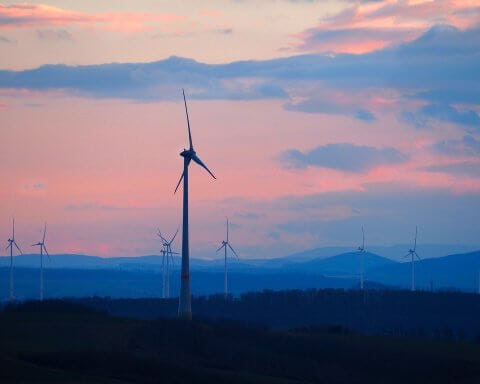The scientific consensus on climate change is increasingly bleak.
As global temperatures continue to climb, the increase in climate extremes is pushing nature and humans “beyond their ability to adapt,” the UN’s Intergovernmental Panel on Climate Change (IPCC) warned in its late-February report. “Any further delay in concerted global action will miss a brief and rapidly closing window to secure a liveable future,” said Hans-Otto Pörtner, one of the report’s co-authors.
Climate breakdown is already causing dangerous and widespread disruption in nature and affecting the lives of billions of people. Impacts include deadly heat waves and other threats to human well-being, ocean acidification and significant species loss.
“Half measures are no longer an option,” said IPCC chair Hoesung Lee.
If the world stands a chance of blunting the worst effects of the climate emergency, its largest economies must move to quickly transition away from burning fossil fuels. And the wealthiest countries must lead the way.
A new Corporate Knights analysis and accountability tool, Earth Index, has revealed that G20 countries, responsible for about 75% of global greenhouse gas (GHG) emissions, remain far off track from meeting their climate targets.
From 2016 to 2019, none of the 10 developed countries that are members of the Group of 20 nations managed to reduce emissions at a rate consistent with their 2030 targets, the index shows.
In 2019, only Germany and Turkey hit their marks. Canada was the worst performer of the developed countries. Its performance was second last to Russia – also a large oil and gas producer – between 2016 and 2019.
Corporate Knights is launching the Earth Index initiative to gauge whether G20 countries are living up to their decarbonization commitments. “We are not on track to meet these targets,” says Ralph Torrie, Corporate Knights director of research. “And for most countries, it’s not even close.”
Half measures are no longer an option.
–IPCC chair Hoesung Lee
In addition to the 10 developed countries, Earth Index monitors nine newly developed or developing countries that are members of the G20 but have different reporting requirements than the Annex 1 nations (which are developed countries and “economies in transition”) under the United Nations Framework Convention on Climate Change (UNFCCC). They include China, India, Brazil, Mexico and Indonesia, and have a mixture of 2030 targets and net-zero goals for 2050 and beyond. Of the nine, only Argentina made enough progress in 2019 to be consistent with its nationally determined goals.
Organizations such as the International Energy Agency and the non-profit Climate Action Tracker initiative have concluded that targets announced last year at COP26, the UN’s climate summit in Glasgow, are insufficient to meet the goal of limiting the rise in average global temperatures to 1.5°C above pre-industrial levels.
Earth Index adds to this analysis by assessing the “say–do” gap – ![]() the shortfall between what countries say they will achieve and what progress they are making toward those goals. “Along with targets that are fit for purpose, we need radical action to meet those targets,” says Corporate Knights co-founder Toby Heaps.
the shortfall between what countries say they will achieve and what progress they are making toward those goals. “Along with targets that are fit for purpose, we need radical action to meet those targets,” says Corporate Knights co-founder Toby Heaps.
Time is running out for governments to get on the right track, says Rick Smith, chief executive officer at the Canadian Institute for Climate Choices. “There are only nine years to 2030 … we have a very short period of time to accomplish some significant changes.” Only in the past couple of years have key pieces begun to fall into place that will enable major emitters to meet their targets, Smith says. That includes the European Green Deal, a renewed commitment from the Biden administration to tackle emissions, and Canada’s own Net-Zero Emissions Accountability Act.
The urgency of the transition was reinforced when energy powerhouse Russia invaded Ukraine at the end of February, plunging commodity markets into crisis and driving oil and gas prices skyward. Fossil fuel producers like Canada and the United States faced calls to increase production to offset falling Russian supplies. European governments are embracing an urgent mixture of conservation and efficiency measures, switching from Russian oil and gas to renewables, looking to other global sources, and in some cases, extending the life of coal and nuclear plants.
Corporate Knights plans to publish the index annually with the intention of holding countries accountable for delivering on their commitments. While a one-year snapshot provides a limited picture in the first year, it will provide key data on the trend line over the coming decade, shining a spotlight on gaps both between countries and within them.
The inaugural Earth Index also allows users to survey national performance over four years between 2016 and 2019, the last year for which reliable data is available. It provides data for key sectors – power, the fossil fuel industry, transportation, industry, buildings, agriculture and waste. It does not include emissions from land use, land use change and forestry, which countries such as Canada rely on for significant emission reductions.
Along with targets that are fit for purpose, we need radical action to meet those targets.
–Corporate Knights co-founder Toby Heaps
For targets, Corporate Knights is using the nationally determined contributions (NDCs) that countries submitted under the UNFCCC process last year ahead of COP26. Corporate Knights will adjust the index if countries come forward with more ambitious targets in future years.
Among the Annex 1 nations, Germany is by far the leader. In 2019, it reduced GHG emissions by 62% above what would be needed at an annual rate to achieve its target of 65% below 1990 levels by 2030. However, even Germany has ground to make up. From 2016 to 2019, it fell 15% short of the reductions needed to be on track, and preliminary 2021 data suggest it continues to fall behind. Recently, Germany announced it would spend €200 billion in an effort to eliminate dependence on Russian gas, but that doesn’t mean it’s shifting away from fossil fuels altogether anytime soon.
The EU also achieved more emission reductions in 2019 than its annualized target requires but made only half the cuts needed between 2016 and 2019 to be on pace.
![]()
The United States is the world’s second-largest emitter after China, and, despite former president Donald Trump’s open hostility toward climate policies, the country did make progress in 2019.
Driven by the power sector, the U.S. achieved 42% of the GHG reductions that were needed on an annualized basis to reach the 2030 target adopted last year by President Joe Biden.
U.S. emissions rose in the fossil fuel, industry, buildings and agriculture sectors. However, the power sector – which accounts for a quarter of the total – saw GHGs fall by nearly 10% as natural gas and renewable electricity replaced coal.
In Canada, by contrast, rising emissions in transportation, buildings and agriculture offset improvements in the power sector and resulted in a small increase in total emissions in 2019.
From 2016 to 2019, Japan and the European G20 members saw emission reductions, while Canada, the United States, Australia, Russia and Turkey increased GHG output. None of the 10 were on schedule to meet the target they adopted in 2021.
“When countries announce long-term goals but neglect the steps required to achieve them, trust plummets, alongside the likelihood that these long-term goals will ever be achieved,” says Heaps. Bending the climate trajectory will take monumental effort from governments and corporations, he adds. “Every person in every country and every sector must play a role, be willing to make compromises, and be willing to take bold action like never before to put the world on a fast track to a low-carbon economy.”
Shawn McCarthy is an Ottawa-based writer who focuses on climate change and the low-carbon economy.
Editor's note, April 21, 2022: A previous version of this article said Canada was the only nation among the nine Annex 1 G20 countries that saw increased emissions in 2019. However, Canada released an inventory report in April that recalculated 2019 emissions in keeping with a change in United Nations’ methodology. These new figures showed a slight decline from 2018.
DOWNLOAD THE FULL REPORT





